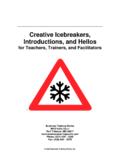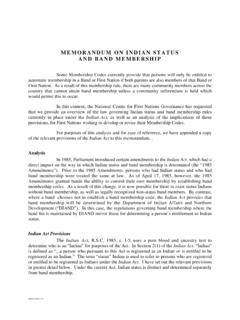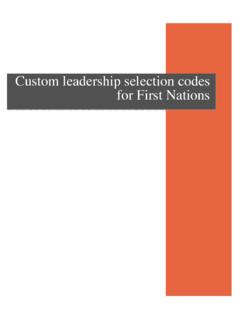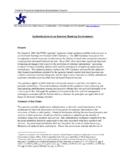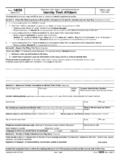Transcription of Reclaiming Our Identity: Band Membership, Citizenship and ...
1 1 Reclaiming Our IdentityBand membership , Citizenship and the Inherent RightNational Centre for First Nations Governance2 IntroductionTo be an Indian in Canada is not just a cultural identity but also a legal , rather than aboriginal communities themselves has through the IndianAct historically legislated who is an are constantly developing our identity , from birth to the end of our lives. Webuild it based on our relationships to relatives, friends, community, geography,language and other social factors.
2 identity plays a key role in our lives. When achild feels a sense of belonging to family, community and peers he or she isbetter able to deal with to contact First Nations had their own histories and methods of determiningour identity . We had matriarchal, patriarchal, clan and kinship systems. BeforeEuropeans came to North America, First Nations communities or nations weresovereign nations, that is, we were self-governing. Our oral history is supportedby the work of anthropologists and historians, and illustrates that there was acomplex system of governance.
3 We also had our own laws and systems ofjustice. Our systems were characterized by oral teachings, collectivities Nations peoples relied on a variety of distinctive and cultural ways toorganize their political systems and institutions. Later, many of these institutionswere ignored or legally suppressed while the federal government attempted toimpose a uniform set of vastly different Euro-Canadian political ideals on FirstNations societies, through various legislative History of identity to the PresentThe Indian Act is federal legislation that governs the lives of all Canadian IndianPeople, from birth to death.
4 Contained within it are provisions and regulationsrelating to all aspects of social and economic life, from Indian registration, to3lands, revenues, education, health status, elections, and estates and wills. TheIndian Act has regulatory power over all facets of Indian life and provides thefederal government with a major concentration of authority and social controlover Indians. That is those that they identify as decide Indian status there is a Registrar in Ottawa who determines who is andwho is not an Indian, based on INAC polices and legislation.
5 The Registrar,accordingly, adds or takes people off a list called the Indian Register. The issueis not who is actually an Indian, but who is entitled to be registered as an Indianaccording to the Indian Act. The Registrar also decides who is not entitled to beregistered in the Indian BackgroundSince 1869 the Indian Act has controlled who would be recognized as Indian inlegal terms. The Indian Act stated; Provided always that any Indian women marrying any other than Indianshall cease to be an Indian within the meaning of this Act nor shall thechildren of such marriage be considered Indians.
6 The first Act to be called the Indian Act was enacted in 1876. It redefined anIndian as; Any male person of Indian blood reputed to belong to a particular band Any child of such person Any person who is or was lawfully married to such personThe Act also spelled out a process of enfranchisement whereby Indians couldacquire full Canadian Citizenship by relinquishing their ties to their community. Adefinition for enfranchisement first appeared in 1876, which stated that anenfranchised Indian is.
7 Any Indian, his wife and or minor unmarried children who has letters4granting him in fee simple any portion of the reserve which may have beenallotted to him, his wife or minor children by the band which he belongs orany unmarried Indian who may have received letters patent for anallotment of the reserve 1 Enfranchisement meant giving up Indian status, culture and traditions, and anyrights to land. You would become a citizen of Canada thereby giving you theright to vote in federal elections and to move freely about the country.
8 Therewere also provisions that any Indian that became a lawyer, doctor or clergymanreceived a degree from a university, or joined the military would be you lost your status you lost the right to live on the reserve and any benefitsthat might be associated with it. The federal government viewed enfranchisementas a way of civilizing and assimilating the 1951, the Indian Act was again amended and Section 12 (1) b was section meant that any Indian woman who married a non-Indian was notentitled to be registered, nor were any children of the marriage.
9 In contrast,section 11(1) (f) was added and stated that the wife or widow of any registeredIndian man was entitled to Indian status irregardless of whether this person wasa 12(1) b was the start of legislated discrimination specifically aimed atIndian women. If an Indian woman married a non-Indian then she would lose herstatus but if a non-Indian women married an Indian man the woman would gainIndian status and become an Indian within the meaning of the Indian Act,despite the fact that the person had absolutely no Indian summary, over the last century and a half the government has developedidentities known as Indian in a chronological order and for various reasonsthese are.
10 1 Indian Act 1876:s55 Indian1850 Any person deemed to be aboriginal by birth or blood, any personreputed to belong to a particular band or body of Indians and anyperson who married an Indian or was adopted by Indians1876 Any male person of Indian blood reputed to belong to a particularband; any child of such person; any woman who is or was lawfullymarried to such person1951 A person who is registered or entitled to be registered in the IndianRegister.



